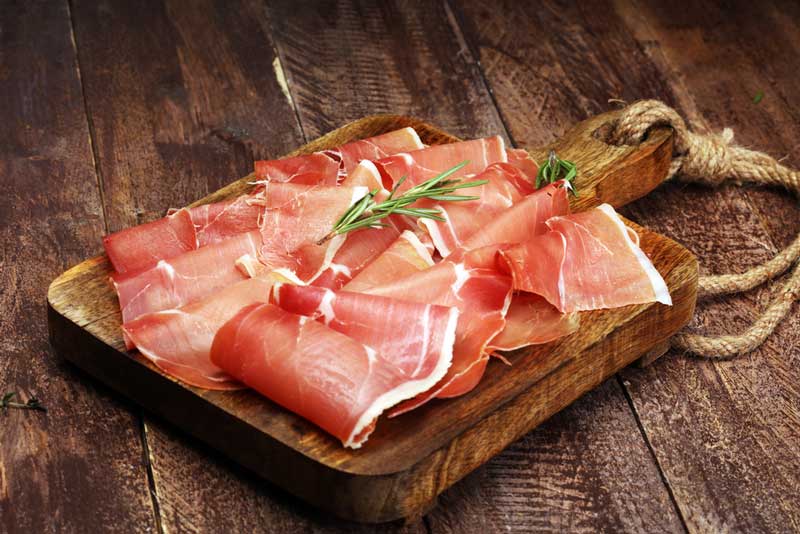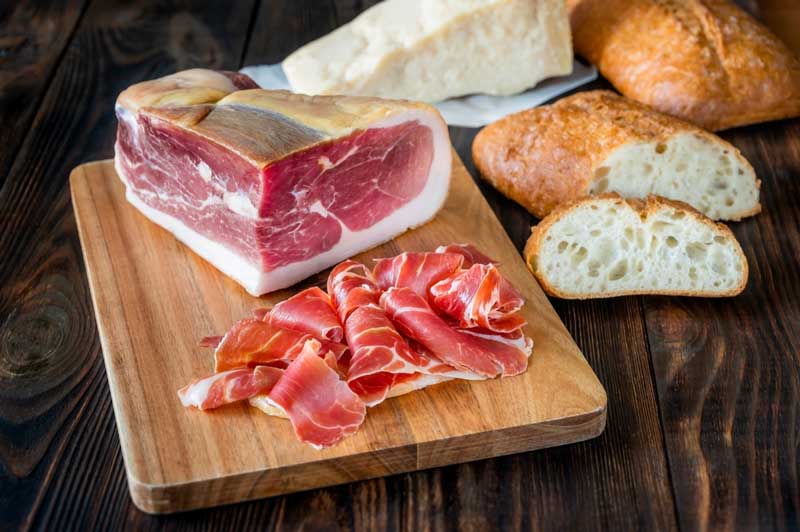Prosciutto is almost like the king of cured meats and is often considered the top contender. Deli meats, in general, add a touch of indulgence to parties, combining subtlety and refinement to create a worthwhile experience.
However, once you truly understand the essence of prosciutto, you’ll realize why it has gained such widespread acclaim worldwide.
But this ham raises a lot of questions. Can you eat Prosciutto raw? What happens if you enjoy it raw? Should I pair it with a sandwich, or should I try it with pasta? And most importantly, is it safe for consumption?
Of course, it is safe for consumption! Prosciutto undergoes a dry-cure method wherein the meat is cured with salt and left to dry for several weeks or even months, so the answer to the question “Can you eat Prosciutto raw?” Is yes, you can have prosciutto in its raw form without any concerns.
While the idea of eating raw meat may seem unconventional to many, it’s important to note that prosciutto is not truly uncooked. The salt-curing and drying process ensures that it is no longer in its raw state.
If you want to know more about Prosciutto and why it can be eaten raw, do read on!
Can You Eat Prosciutto Raw?
Absolutely! Prosciutto is meant to be enjoyed in its raw form, nicely diced, and presented.
The prepping of prosciutto with salt effectively extracts blood and other fluids, acting as a safeguard against the intrusion of bacteria. This ensures that it is okay to consume without further changes.
The Italians, mainly, firmly believe that this artisanal delicacy is best enjoyed in its unaltered form. They can be accompanied by toasted bread, Parmigiano-Reggiano, melons, and other side dishes, allowing their authentic flavors to shine.
What Is Prosciutto?
If you’ve ever had the opportunity to partake in a festive gathering where the host presented a spread of cured meats, chances are you’ve had the sweet flavors of prosciutto firsthand! This delicacy holds a profound significance for many individuals, and for good reason.
Prosciutto is often considered the world’s most loved salumi. Let’s start by breaking down the essence of the word itself – prosciutto, which aptly translates to ham.
It is air-dried ham that has been finely diced, following a long-established Italian practice specific to certain regions.
This wonderful treat originates solely from the hind leg of pork, a lean cut that significantly benefits from both wet and dry curing techniques, as well as smoking methods.
Unlike roasting, which can lead to dryness, the carefully marbled fat present throughout the leg plays a crucial role in ensuring consistent flavor development during the aging process.
This marbling gives rise to the satisfying sensation of prosciutto effortlessly melting in your mouth.
Now moving on to the second aspect worth noting, while there exist different variations and types of prosciutto, which we will further explain in this article, there are primarily two types of prosciutto.
Prosciutto Crudo pertains to raw ham, the traditional form of cured prosciutto, while prosciutto Cotto refers to cooked ham.
Also Read: How Long to Rest Brisket? (Explained) and What Does Ostrich Taste Like? (Answered)
Why can it be eaten Raw?
After answering the question, Can you eat Prosciutto raw? You might need further explanation on how this is possible.
The finest pork legs form the foundation of prosciutto’s creation. First, the meat is generously coated with salt and allowed to repose for several weeks. During this period, the salt extracts both blood and moisture, effectively safeguarding the meat against bacterial intrusion.
These production processes make prosciutto a safe and palatable option for consumption, even in its “raw” state.
Different Kinds of Prosciutto
As we delve further into prosciutto knowledge, it becomes apparent that there exist several distinct varieties of this cured meat.
We understand that dry-curing prosciutto is characterized by intricacy, and even the slightest alteration in the procedure can result in a subtly different meat character.
Various factors, including the pig’s breed, diet, and the choice of seasonings, contribute to the texture and flavor profile of prosciutto. Let us now explore a few of the diverse types of prosciutto.
- Prosciutto di Parma
In as much as there’s a universal admiration for Italian prosciutto because of its delicate nature and taste, Prosciutto di Parma is also cherished for its remarkable value. Distinguished by a lengthier curing process, this variety has tactile quality and a velvety flavor profile.
- Prosciutto Tuscano
Originating from Tuscany, Italy, this particular type of cured ham stems from a region known for its thriving pig farming industry, providing a lucrative source of income for many.
Due to the spice mixture that includes herbs and seasonings, including pepper, the prosciutto here features a dark rind. Prosciutto Tuscano, should you come across it, signifies that the meat originates from pigs bred in Tuscany before being processed.
- Prosciutto di San Daniele
San Daniele, Italy, is home to Prosciutto di San Daniele. The cured ham passes through a distinctive salting method with sea salt, followed by a three-day pressing period to enhance the flavor.
Do You Need to Cook Prosciutto?
Prosciutto is widely regarded as safe for raw consumption thanks to the dry-aging process that it undergoes. This includes salting to inhibit the growth of bacteria.
Indeed, it is possible to cook prosciutto; however, it may compromise its composition and essence.
Prosciutto undergoes an extensive process of drying and curing for several months. At this point, the meat is no longer raw and becomes edible because this procedure renders it suitable for consumption.
What Does Prosciutto taste like?
Curious about the taste of prosciutto? Prosciutto offers gentle sweetness and a touch of saltiness. The slices have delicate fat marbling, presenting a color spectrum ranging from pink to dour-red.
Certain prosciutto variations incorporate additional seasonings like garlic, rosemary, or black pepper to get that aromatic flavor.
Prosciutto also exhibits a range of flavors, commonly characterized by its saltiness and overall richness. While the flavor profile may evolve as it ages, the fundamental quality remains consistent.
It is an outstanding exemplar of cured meats, where dry curing intensifies its distinctive salty taste compared to uncured counterparts.

How Best Can Prosciutto Be Eaten?
By now, you must be well aware of your love for prosciutto. But have you ever wondered about the extent of creativity this specialty presents in terms of culinary exploration and adventure?
This intricate and indulgent cured meat delicacy has a foolproof choice that never fails to impress, and when it comes to presenting prosciutto, the possibilities are endless. So let us look at various ways you can serve and eat prosciutto!
- Drizzle It
To create and enhance the richness of taste, char a piece of bread on the grill, layer it with chops of Italian ham, and generously trickle the ensemble with olive oil.
- Skewer It
Are you still wondering why skewers have a crowd-pleasing appeal? When you dice fresh tomatoes, basil leaves, and mozzarella, then artfully thread them onto a skewer, you have created a portable antipasto masterpiece ideal for any occasion.
- Sandwich It
Revisit the fundamentals by making a good old sandwich meal with prosciutto. Stuff a baguette generously with either prosciutto cotto or crudo and any other assortment of your choice, and there you have it; an original panino!
- Wrap It
Prosciutto and fruits go hand in hand. Fruits have long been celebrated as a perfect companion to cured meat, as it wonderfully complements the meal’s tastiness.
You can enfold slices of prosciutto around cantaloupe for a genuinely timeless indulgence. Basil leaves make for a nice garnishing, and pears for delightful accompaniments.
- Slice It
For a top-notch experience, prosciutto is best enjoyed when sliced to order. Alternatively, you can choose pre-sliced options available in the market.
When it comes to serving, prosciutto pairs wonderfully with creamy mozzarella cheese.
Also Checkout: Can Dogs Eat Sausage? (Everything to Know) and Are Boneless Wings Chicken Nuggets? (Answered)
Frequently Asked Questions-Can You Eat Prosciutto Raw?
Is Prosciutto Cooked or Raw?
Cooking prosciutto is generally discouraged because it compromises its authentic flavor and texture. During its preparation, it is coated with salt to extract moisture and blood.
This makes it safer for consumption without further cooking as it has been safeguarded against bacterial growth.
How Should Prosciutto Be Eaten?
In Italian cuisine, it is common for prosciutto to be skewered or wrapped around pieces of cheese to create a fantastic flavor combination.
Prosciutto is also a decadent accompaniment to sandwiches, like panino and pizza. So while you can fully enjoy prosciutto alone, it is also an excellent complementing ingredient.
What Food Goes Well With Prosciutto?
It is exciting to know that enhancing dishes by coating them with prosciutto is a surefire way to improve them, and there are a lot of excellent foods that pair exquisitely with prosciutto! Some perfect companions include arugula, pasta, cheese, and melon.
You can even try swathing pork roast in Pancetta and stuffing it with golden raisins or fennel. Prosciutto also serves as a beautiful topping for pizzas, adding a pleasing dimension that is consistently reliable.
Can Prosciutto Be Heated Up?
The versatility of prosciutto allows you to enjoy it both cold and hot. If you prefer hot, remove your prosciutto from the refrigerator and allow the oven to preheat to 350°F.
The next thing you’ll want to do is keep your cured meat on a baking tray and place it in the oven for 5 minutes.
Is Prosciutto Good for You?
Due to its nutritional composition, prosciutto does offer benefits for physical vitality. As a meat-based product, it provides a substantial amount of dietary protein, providing approximately 8g per serving.
It also contains essential vitamins and minerals, including thiamine, contributing to overall health.
One notable aspect of prosciutto is its principal fatty acid content, primarily oleic acid, a cardio-protective fat known for its potential benefits in promoting cardiovascular health.
How Long Is Prosciutto Safe To Eat?
Prosciutto is commonly available in tightly sealed packages to prevent air exposure. It can maintain its quality for two years when stored in its original airtight packaging.
However, once you unseal the package and the prosciutto comes into contact with air, it can still be safely stored in the refrigerator for a few weeks without compromising its freshness.
Conclusion-Can You Eat Prosciutto Raw?
This article has answered the question Can you eat Prosciutto raw?
Are you still having reservations about trying prosciutto fueled by concerns over eating “uncooked” meat? Hopefully, we have answered some of your questions and maybe even piqued your curiosity!
Contemplating raw food consumption might appear crazy, yet prosciutto defies this notion as it undergoes a comprehensive preservation process.
Incorporating prosciutto as an occasional indulgence or as a component of a wholesome and diverse diet can contribute to a nourishing eating regimen.
Creating a balanced meal, too, by combining prosciutto with whole grains, lean proteins, fruits, and vegetables, can aid in addressing potential health concerns.

